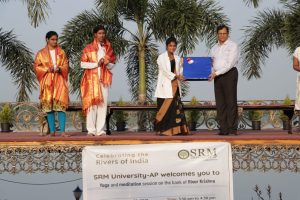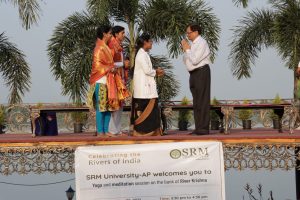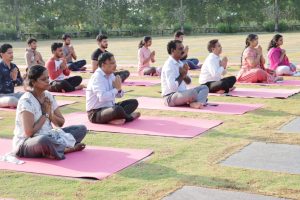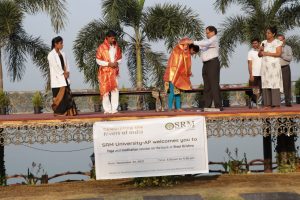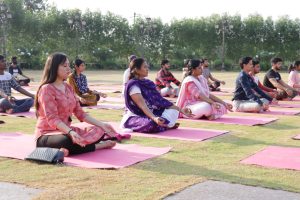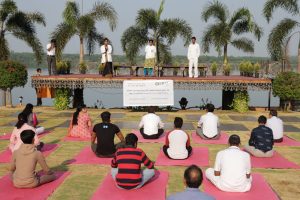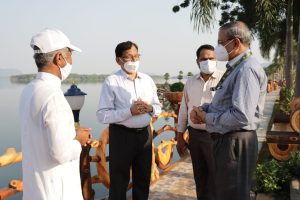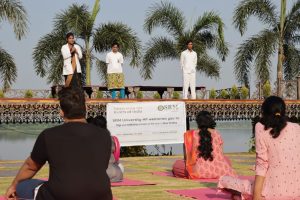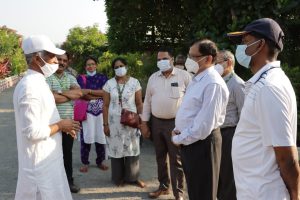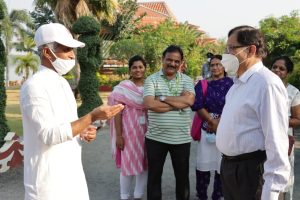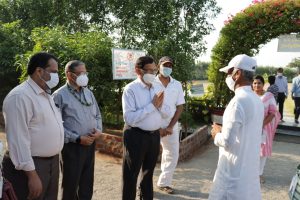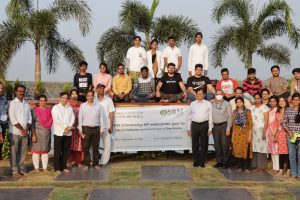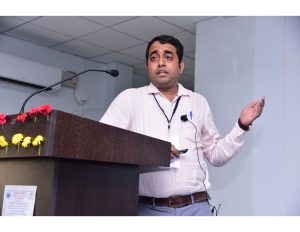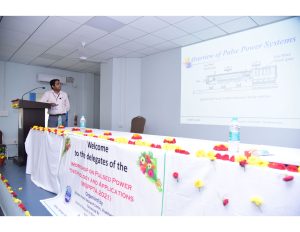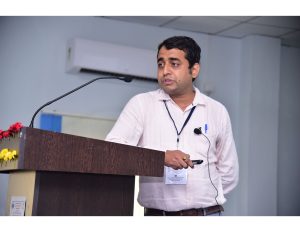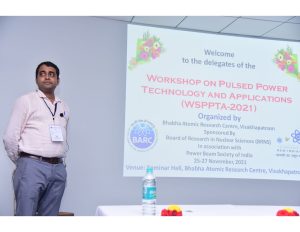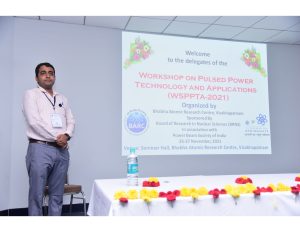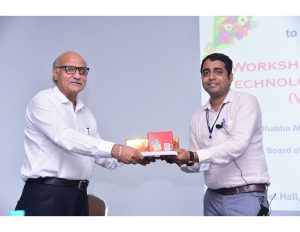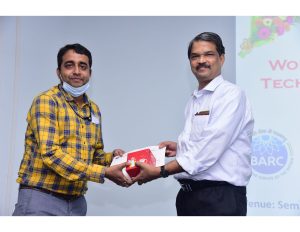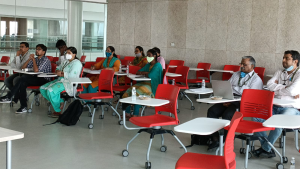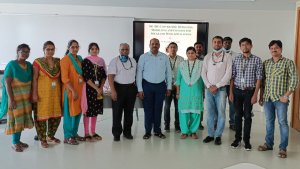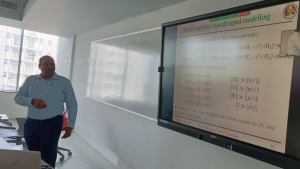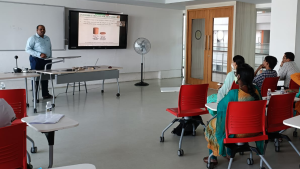Dr Inbarasan Muniraj receives SERB-SRG-DST grant to improve low light imaging
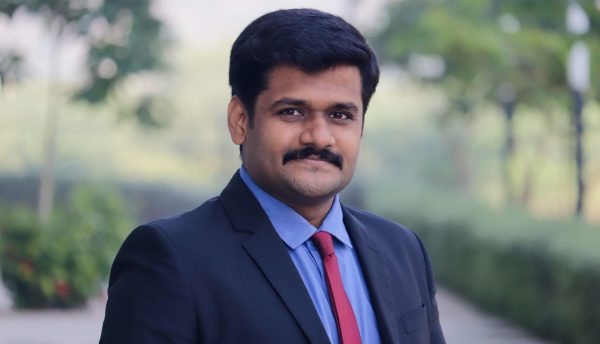 Imaging various three-dimensional (3D) objects under ultra-darkness is a fascinating process. However, our conventional cameras are not intelligent enough to capture the experience. Dr Inbarasan Muniraj, Assistant Professor in the Department of Electronics and Communications Engineering, is all about changing that.
Imaging various three-dimensional (3D) objects under ultra-darkness is a fascinating process. However, our conventional cameras are not intelligent enough to capture the experience. Dr Inbarasan Muniraj, Assistant Professor in the Department of Electronics and Communications Engineering, is all about changing that.
Dr Inbarasan Muniraj’s project, “Sensing in the dark: An automated off-focused points detection and removal from the photons starved 3D volumetric dataset”, has received a SERB-SRG-DST of Rs. 20.8 lacs for a two-year duration.
Dr Muniraj describes his project as such,
“Assume that there is no external light, e.g., a dark room, when you capture an image using a camera (mobile or DSLR). Often, the captured images will look dark, and it is too difficult tointerpret anything from the picture. However, algorithms have been developed to make use of the low scattered photons from a scene to estimate the equivalent normal intensity image. We use one such technique to generate photons-counted images for a 3D object and perform a 3D image reconstruction. One of the major problems in 3D reconstruction is off-focused points which look blurry and redundant. Therefore, in this project, we aim to employ a deep learning technique to smartly recognise and remove the off-focused points from a reconstructed 3D scene under photons starved conditions.”
Dr Inbarasan Muniraj is the sole investigator of this project. According to him, there are much more extensive social implications associated with this project. To note, this technique can be extended for various applications such as night vision, security, and biomedical imaging etc.
- Published in Departmental News, ECE NEWS, News, Research News
SRM University-AP takes part in Celebrating the Rivers of India
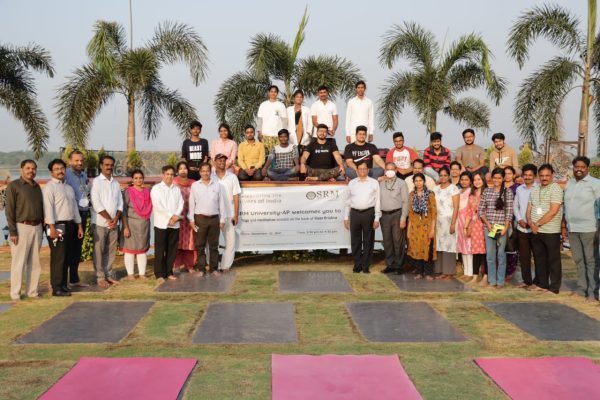 The students, faculty, and other staff members of SRM University-AP spent a memorable evening on the banks of River Krishna as a part of Celebrating the Rivers of India.
The students, faculty, and other staff members of SRM University-AP spent a memorable evening on the banks of River Krishna as a part of Celebrating the Rivers of India.
As a part of Azadi ka Amrit Mahotsav, the Ministry of Jal Shakti, Government of India, organises various programmes on the theme Celebrating the Rivers of India. This revitalising excursion organised by the Department of Student Affairs at SRM AP was held in honour of the fourth largest river at Manthena Satyanarayana Arogyalayam, Thullur, Vijayawada.
Dr Manthena Satyanarayana introduced the gathering to the practice of naturopathic medicine which is based on modern and traditional, scientific, and empirical methods. Dr Gangadhar, Ms Chaitanya and Dr Prema led a short rejuvenating yoga and meditation session for the participants.
The practitioners at the Arogyalayam were honoured with stoles and mementos as tokens of appreciation. Dr R Premkumar-Registrar, Directors of various departments, and Deans of schools were present on the occasion.
Arogyalayam Research Centre advocates protecting health by increasing the level of immunity and enhancing life-force (praana sakti) amidst very pleasing natural environs, with the help of experts and experienced personnel, under the overall supervision of Dr Manthena Satyanarayana.
“The waterfront and the refreshing greenery of nature heals our mind and soul in this stressful modern-day life”, said Prof V S Rao, Vice-chancellor, SRM University-AP. The event, organised for Celebrating the Rivers of India, gave the participants an opportunity to unwind, relish the view of boats gliding smoothly on the river, enjoy the lush bushes growing all around, and do yoga in the delightful breeze with serene atmosphere.
- Published in News
Higher education abroad might be easier than you think
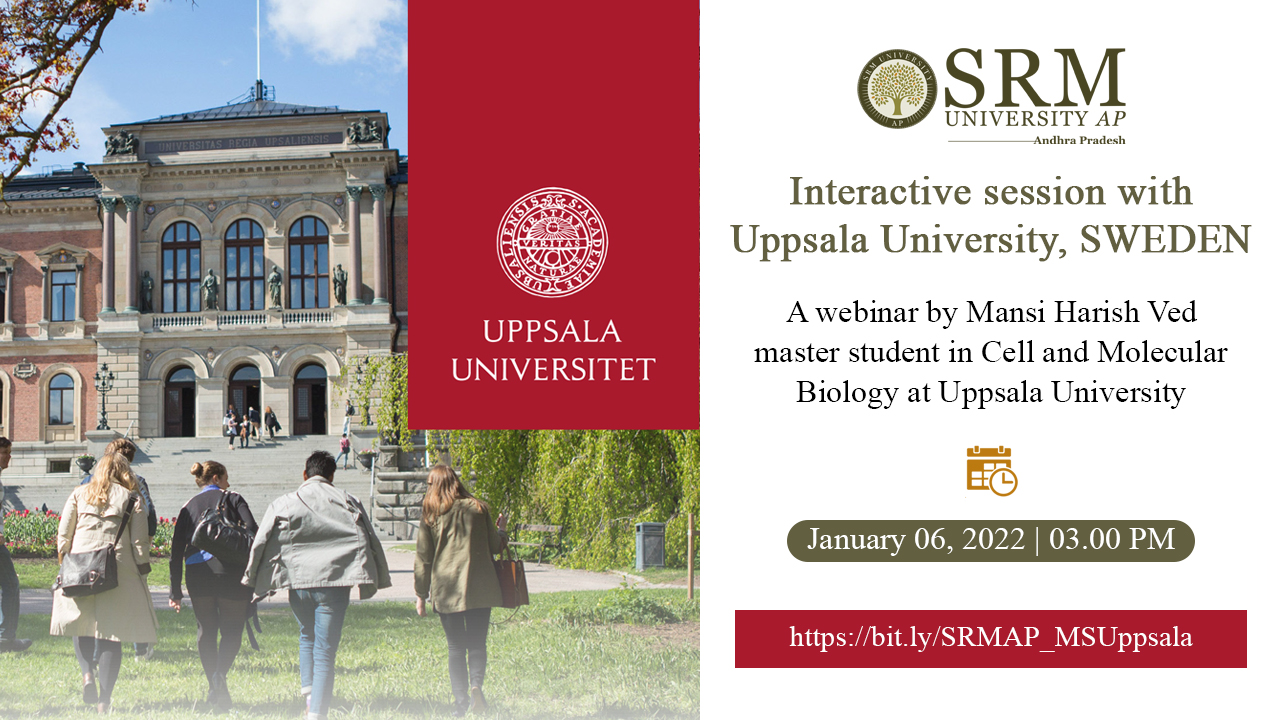 Do you dream about studying at a high-ranking university abroad?
Do you dream about studying at a high-ranking university abroad?
The Department of International Relations has arranged an exciting session to help you realize your higher education abroad dreams. From the land of the Northern Lights, Uppsala University (Sweden) brings you an insight into the opportunities available at one of the most reputed institutes in the world.
Mansi Harish Ved, master student in Cell and Molecular Biology, will join us from Uppsala University and share her experience to help others pursue their studying abroad dream.
Join the webinar on January 06, 2022, at 3.00 pm IST and see what your life at Uppsala University could look like. This session might be the ticket to your dreams of receiving higher education abroad.
- Published in Events, International Relations, IR-Events
Invited talk at Workshop on Pulse Power Technology and Applications (WSPPTA-2021)
Dr Somesh Vinayak Tewari delivered an invited talk on “High Power Closing Switches” on November 25, 2021, during the Workshop on Pulse Power Technology and Applications (WSPPTA-2021) held from November 25, 2021, to November 27, 2021, at Bhabha Atomic Research Centre (BARC) Facility, Visakhapatnam, sponsored by Board of Research in Nuclear Sciences (BRNS), Department of Atomic Energy, Government of India in association with Power Beam Society of India.
The workshop served as a platform for pedagogical presentations, discussions on intricacies of pulsed power technology and mutual interactions among young researchers, engineers and students from academia and applied research laboratories and talks were delivered by scientists of BARC, IPR, DRDO, CEERI, professors from IIT, IISc and experts from industry.
Dr Tewari delivered a talk on “High Power Closing Switches”, highlighting the working principle, mechanism, and applications of vacuum switches like ignitron, thyratron, pseudo spark gap, gas-filled spark gap switches, liquid and solid dielectric switches, magnetic switches, and modern-day semiconductor switches.
After his talk, Dr Tewari was highly appreciated and felicitated by Dr D. C. Pande, Dr Raja Ramana Distinguished Fellow of DRDO. The proceedings were compiled in the form of book chapters and circulated to participants.
- Published in Departmental News, EEE NEWS, News
Guest Lecture on “DC-DC Converters: Operation, Modelling and Control for Solar and Wind Applications”
The Department of Electrical and Electronics Engineering at SRM University-AP organized a guest lecture titled “DC-DC Converters: Operation, Modelling and Control for Solar and Wind Applications” on December 3, 2021, at 11.00 am IST as part of the Departmental Lecture Series.
An eminent resource person, Dr. Ravindranath Adda, Assistant Professor, Department of Electrical and Electronics Engineering, IIT Guwahati, delivered the intriguing talk as the guest lecture. Many undergraduate students of EEE, research scholars and faculty members of SRM University-AP attended the riveting session.
In his lecture, Dr Adda discussed about the importance of DC-DC converters for solar PV and Wind power applications and emphasized the different non-isolated and isolated converter topologies. He also explained the output power variation of the solar PV or wind turbine as a function of weather conditions, and hence the requirement of DC-DC converters and storage systems to transfer the energy from non-conventional energy sources.
Finally, he discussed about the research scope of DC-DC converters, to increase gain, expedite efficiency, reduce the bulk, dynamic modelling, and large scale and small-scale modelling of DC-DC converters.
The lecture concluded with an energetic note with all the participants looking forward to putting to use all the knowledge and information that they had acquired because of it.
- Published in Departmental News, EEE NEWS, News
Dynamic economic and emission dispatch with renewable energy integration
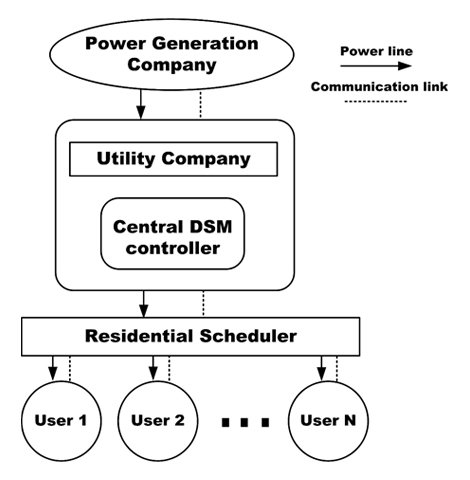 Nowadays, the energy demand of the present electrical power industry is increasing exponentially, and most of the electricity production depends on fossil fuel resources. A research paper titled “Dynamic Economic and Emission Dispatch with Renewable Energy Integration Under Uncertainties and Demand Side Management”, published by Dr B Lokeshgupta, Assistant Professor, Department of Electrical and Electronics Engineering, SRM University-AP, Andhra Pradesh, answers some of the pertinent questions regarding reducing the environmental pollution level.
Nowadays, the energy demand of the present electrical power industry is increasing exponentially, and most of the electricity production depends on fossil fuel resources. A research paper titled “Dynamic Economic and Emission Dispatch with Renewable Energy Integration Under Uncertainties and Demand Side Management”, published by Dr B Lokeshgupta, Assistant Professor, Department of Electrical and Electronics Engineering, SRM University-AP, Andhra Pradesh, answers some of the pertinent questions regarding reducing the environmental pollution level.
Integration of renewable energy resources (RERs) along with demand-side management (DSM) is almost inevitable in the present scenario to meet the growing energy demand with minimum environmental pollution. This work proposes a combined model of dynamic economic and emission dispatch (DEED) and DSM to integrate renewable energy resources (RERs). In this analysis, the DSM load-shifting scheme is incorporated with the DEED problem to obtain the generation side operational benefits as well as the reduction in environmental pollution level. In this study, various smart home appliances and their complex constraints are included in the DSM load shifting process. The variability and stochastic nature of the load demand and RERs such as solar, wind are modelled with Normal, Beta, and Weibull distribution functions, respectively. The proposed model is implemented in both deterministic and stochastic approaches with the help of the non-dominated sorting genetic algorithm (NSGA-II) and the Monte Carlo Simulation (MCS) approach. In the stochastic model, the MCS approach appropriately handles the uncertainties of system load demand and RERs. Four different case studies are carried out in the simulation analysis to show the impacts of RERs and DSM integration on the traditional DEED problem.
Meeting the excessive energy demand with the minimum environmental pollution is a challenging task. The integration of RERs such as wind and solar into the grid is one of the superior solutions for this issue. However, the variability and uncertainty of the RERs bring challenges to the power system operation. Energy management schemes such as demand-side management (DSM) methods can help the power industry address the challenges of RERs integration. That is why the combination of renewable energy integration and DSM is one of the key solutions in the smart grid environment to meet the increased energy demand with the lowest possible energy cost and minimum pollution level. The RERs and DSM combination gives several financial, environmental, and technical benefits to the power industry along with a better system operation.
The dynamic economic and emission dispatch (DEED) is one of the widely adopted tools in the operation and planning of power systems. Both DEED and DSM are the essential tools in the smart grid environment for efficient energy management with the concern of economic and environmental aspects. The DEED’s primary task is to obtain the optimal scheduling of generators with minimum cost and emission for the given load demand. At the same time, the DSM’s primary goal is to improve the optimal values of system objective functions by shifting or managing the controllable loads of consumers. This work introduces a combined stochastic optimisation model of DEED and DSM scheme with the integration of solar and wind energy to show how DSM and RERs bring benefits to a generation company, and also to get better optimal operation cost and emission values simultaneously. The DSM load-shifting scheme is implemented in this study with the help of 10,000 active residential consumers. The effectiveness of the proposed combined model has been tested on a system of six thermal generating units, one wind-powered generator, and one solar-powered generator. The MCS approach and NSGA-II method are used in this paper to solve the proposed stochastic combined DEED and DSM optimisation model.
From the overall analysis, it is recognized that the implementation of the DSM load-shifting scheme along with RERs integration is essential for future smart grids to improve the financial savings of generation companies as well as to reduce the environmental pollution level. The paper is written in collaboration with Dr S Sivasubramani, Associate Professor, Department of Electrical Engineering, Indian Institute of Technology, Patna.
In future, the proposed DSM optimisation can be extended with the inclusion of a neighbourhood power-sharing model in the environment of multiple smart home consumers and prosumers. The proposed DSM model can also be integrated with the distribution network planning and operation problems to enhance the financial and technical benefits of distribution companies.
- Published in EEE NEWS, News, Research News
Dr Chennupati Jagadish on Semiconductor Nanostructures for Optoelectronics Applications
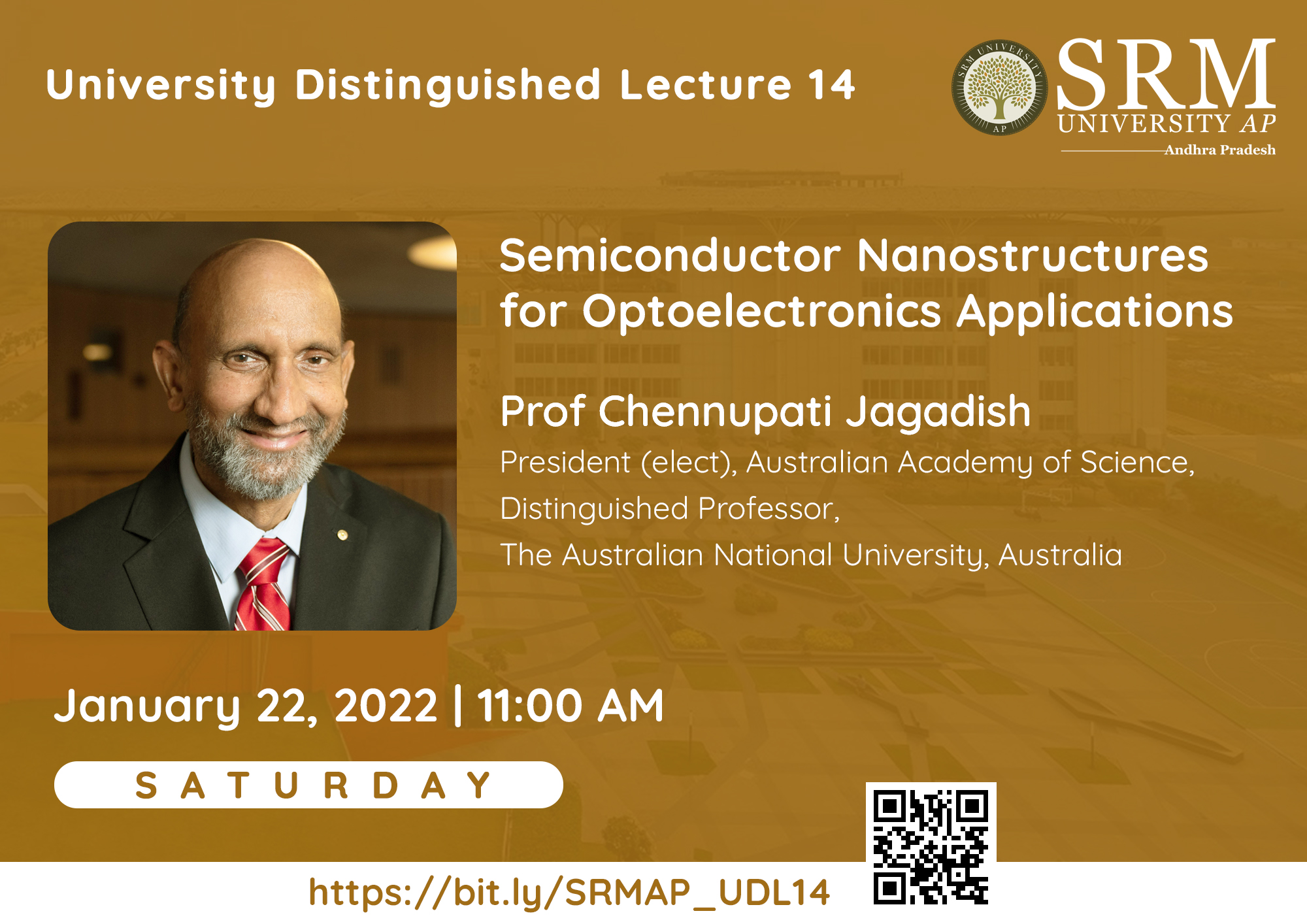 In the next installment of the University Distinguished Lecture, SRM University-AP brings to you Dr Chennupati Jagadish, a distinguished professor in Physics in the Research School of Physics and Engineering at the Australian National University. He leads the Semiconductor Optoelectronics and Nanotechnology Group as its head since its establishment in 1990 by him.
In the next installment of the University Distinguished Lecture, SRM University-AP brings to you Dr Chennupati Jagadish, a distinguished professor in Physics in the Research School of Physics and Engineering at the Australian National University. He leads the Semiconductor Optoelectronics and Nanotechnology Group as its head since its establishment in 1990 by him.
Date: January 22, 2022 (Saturday)
Time: 11.00 am IST
About the Topic:
Semiconductors have played an important role in the development of information and communications technology, solar cells, solid state lighting. Nanowires are considered as building blocks for the next generation electronics and optoelectronics. In this talk, I will present the results on optoelectronic devices such as lasers/LEDs, THz detectors, energy devices such as solar cells, photoelectrochemical (PEC) water splitting and Neuro-electrodes. Future prospects of the semiconductor nanowires will be discussed.
About the Speaker:
Dr Chennupati Jagadish obtained his Bachelor of Science degree in Physics from the Acharya Nagarjuna University in Tenali, Andhra Pradesh in the year 1977. He received his Master of Science in Applied Physics with a specialisation in Electronics from Andhra University in the year 1980. He acquired his PhD in Physics, by working on ‘Semiconducting Thin Films’, from the University of Delhi in the year 1986. He also held the position of a post-doctoral fellow in the Queens University.
Dr Jagadish moved to the Australian National University in the year 1990 and joined the newly established Department of Electronic Materials Engineering in the Research School of Physics and Engineering. He was the Vice-President and Secretary at the Australian Academy of Science for Physical Sciences for four years.
Committed to his role as an academician, Dr Jagadish also holds many honorary and guest faculty positions around the world in leading Universities such as the Oxford University, the Cambridge University, South Central University (The Republic of China), the University of Electronic Science and Technology of China, the University of Tokyo and the Taiwan National University to name a few.
He makes a frequent appearance, by invitation, to various international conferences and seminars on Material Sciences, Electronics, Quantum Electronics, Semiconductors, Physics, Photonics, and Material Sciences. As an active member of the Material Research Society, IEEE, he has delivered many talks and guest lectures as well as organised several sessions in MRS, IEEE meetings throughout the world.
Dr Chennupati Jagadish is currently the Editor-in-Chief for Applied Physics Reviews. He was earlier the Editor-in-Chief for Progress in Quantum electronics and Co-Editor-in-chief for the International Journal of High-Speed Electronics and Systems. He is also the Editor for the Journal of Semiconductor Technology and Science, Springer Series in Material Science, Springer Series in Nanoptics and Nanophotonics, Elsevier Series in Semiconductors and Semimetals, IEEE Electron Device Letters, and Light: Science and Applications of Nature Publishing Group. He is a member of the Editorial Boards of over 20 journals including ACS Nano, Physica Status Solidi: Rapid Res. Lett., IEEE Nanotechnology Magazine, IEEE Photonics Journal, Solid State Electronics, among others.
Dr Jagadish holds many laurels to his name. He became a Champion of the Order of Australia for his eminent contributions to Physics and Engineering at the Australia Day Honours 2016. He has acquired the IEEE Pioneer Award in Nanotechnology (2015), the Walter Boas Medal from the Australian Institute of Physics (2013) and the Thomas Ranken Lyle Medal from the Australian Academy of Science (2019).
He became an elected Fellow of the American Physical Society (2003). In 2020, he also became an elected member of the National Academy of Engineering for his contributions to the nanotechnology of optoelectronic devices. The Australian Research Council awarded him with the Federation Fellowship (2004-09) and with the Laureate Fellowship (2009-14).
It would be a privilege to have Dr Chennupati Jagadish, an astoundingly celebrated research personality, in our midst. We urge everyone to make the most of this opportunity. The University Distinguished Lecture (UDL) hosted by SRM University-AP is attended by about 2000 members from IITs, NITs, IISERs, Universities/Institutions, CSIR, DST, DBT, DRDO, DAE, ISRO, NARL, MoES and several others from different parts of the country.
SRM University-AP cordially invites everyone to the fourteenth University distinguished Lecture on January 22, 2022, Saturday at 11.00 am IST.
Register to Join: https://bit.ly/SRMAP_UDL14 (Registration Closed)
- Published in Events, Research Events, University Distinguished Lecture
Efficient algorithms for dualisation problem for subclasses of Boolean functions
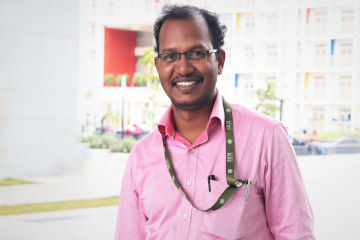 SERB-DST projects aim to build up the best systems that would match the best global practices in the area of promotion and funding of basic research. Dr Murali Krishna Enduri, Assistant Professor, Department of Computer Science Engineering at SRM University-AP is yet another faculty member who has obtained a project with a total outlay of ₹18 lacs for a duration of three years. The project is sanctioned under the scheme of Teachers Associateship for Research Excellence (TARE) of SERB-DST, Government of India.
SERB-DST projects aim to build up the best systems that would match the best global practices in the area of promotion and funding of basic research. Dr Murali Krishna Enduri, Assistant Professor, Department of Computer Science Engineering at SRM University-AP is yet another faculty member who has obtained a project with a total outlay of ₹18 lacs for a duration of three years. The project is sanctioned under the scheme of Teachers Associateship for Research Excellence (TARE) of SERB-DST, Government of India.
In the duality theory, the dual problem is the problem of checking the duality of a pair of monotone Boolean expressions in disjunctive normal form. Problem: DUAL Input: The complete DNF of two monotone Boolean functions, f and g. Output: If f is dual of g. Whether the problem DUAL admits a polynomial-time algorithm has been one of the challenging open problems in the field of Duality theory of Boolean function for the last 35 years. It is one of the few problems whose polynomial-time solvability is still unknown. So, this problem is important in complexity theory due to its unknown complexity status and it plays a central role in various applications arising in computational logic, data mining, reliability theory, artificial intelligence and game theory etc. The project goal is to solve the dual problem for an interesting class of Boolean functions. Improving the existing complexity results of the DUAL problem for a particular class of Boolean functions is a challenging task.
Few applications of the project are as follows:
Type error diagnosis: Type error diagnosis is the task of generating an explanation for some error. It requires finding all minimal unsatisfiable subsets of a given set of constraints (representing the error) which can be managed via solving the computational variant of Dual in its minimal transversal formulation.
Computational medicine: Optimal vaccination strategies are given a subset of initially infected individuals from a population of individuals and assumptions about disease transmission. The task of computing inclusion minimal vaccination strategies can be solved using the computational variant of Dual in its transversal hypergraph formulation.
The project will be carried out in collaboration with IIT Madras (Dr Jayalal Sarma, Associate Professor, Department of Computer Science & Engineering, Indian Institute of Technology Madras, Chennai, India.)
- Published in CSE NEWS, Departmental News, News, Research News
Dr Nimai Mishra on The Impact of Shell Thickness on Charge Transfer Dynamics in Green Emitting Core/Shell Giant Quantum Dots
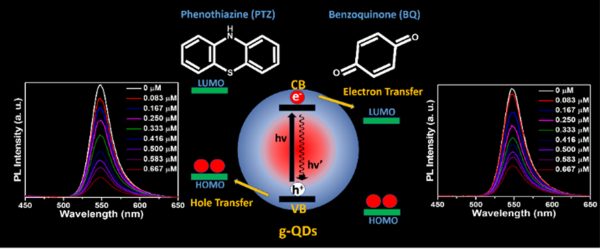 Dr Nimai Mishra, Assistant Professor, Department of Chemistry, SRM University-AP, Andhra Pradesh, along with his research group comprising of students pursuing PhD under him, Mr Rahul Singh, Mr Syed Akhil, and Ms V. G. Vasavi Dutt, have published a research article titled “Study of Shell Thickness Dependent Charge Transfer Dynamics in Green Emitting Core/Shell Giant Quantum Dots” Nature Index journal, “Inorganic Chemistry” published by The American Chemical Society having an impact factor of 5.1.
Dr Nimai Mishra, Assistant Professor, Department of Chemistry, SRM University-AP, Andhra Pradesh, along with his research group comprising of students pursuing PhD under him, Mr Rahul Singh, Mr Syed Akhil, and Ms V. G. Vasavi Dutt, have published a research article titled “Study of Shell Thickness Dependent Charge Transfer Dynamics in Green Emitting Core/Shell Giant Quantum Dots” Nature Index journal, “Inorganic Chemistry” published by The American Chemical Society having an impact factor of 5.1.
About the paper:
The superior photostability enables green-emitting graded alloy core/shell giant quantum dots (g-QDs) for optoelectronic application. However, it is essential to understand how the shell thickness affects interfacial charge separation. This work explores the impact of shell thickness on photoinduced electron transfer (PET) and photoinduced hole transfer (PHT) with an electron acceptor benzoquinone and a hole acceptor phenothiazine, respectively. The four graded alloy core/shell green-emitting g-QDs with different shell thicknesses were synthesised. The PET and PHT rate constants were obtained from photoluminescence and PL-lifetime decay measurement. Our study concludes that g-QDs with a diameter ~7.14 show a substantial improvement in charge transfer than g-QDs ≥ 8.5 nm in diameter. Similarly, the PET and PHT rates are 3.7 and 4.1 times higher for 7.14 nm g-QDs than for the 10.72 nm sample. The calculated electron and hole transfer rate constant (ket/ht) of g-QD with 7.14 nm in diameter are 10.80 × 107 s-1 and 14 × 107 s-1, which shows 8.5 and 8 times higher compared to g-QDs with a 10.72 nm in diameter.
Industrial implications:
More importantly, these results highlight the impact of shell thickness on the excited state interactions of green-emitting g-QDs and conclude that g-QDs with a relatively thin shell can be a better choice as photoactive materials for photocatalysts, photodetectors, and solar cells.
Want the complete details of Dr Nimai Mishra’s paper?
- Published in Chemistry-news, Departmental News, News
Ms Tanoogna bags three gold medals at National Indoor Archery Championship-2021
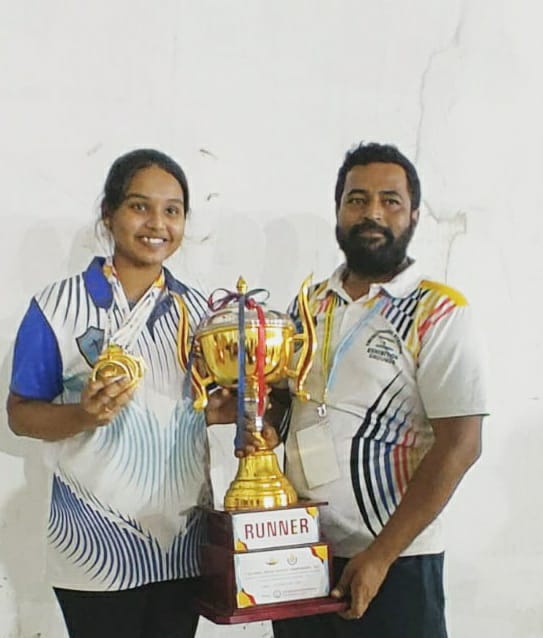 Mallarapu Tanoogna, a third-year civil engineering student at SRM University-AP, has excelled at National Indoor Archery Championship-2021, winning three gold medals and finishing 8th in the National Open Ranking, representing Andhra Pradesh. The National Field Archery Development & Welfare Association in Salem, Tamilnadu, hosted the inaugural National Indoor Archery Championship-2021 on 25th and 26th December. Archery players from the South Indian states of Kerala, Tamil Nadu, Karnataka, Andhra and Telangana participated in the competition.
Mallarapu Tanoogna, a third-year civil engineering student at SRM University-AP, has excelled at National Indoor Archery Championship-2021, winning three gold medals and finishing 8th in the National Open Ranking, representing Andhra Pradesh. The National Field Archery Development & Welfare Association in Salem, Tamilnadu, hosted the inaugural National Indoor Archery Championship-2021 on 25th and 26th December. Archery players from the South Indian states of Kerala, Tamil Nadu, Karnataka, Andhra and Telangana participated in the competition.
Ms Tanoogna, representing Andhra Pradesh from SRM AP has been training to participate in indoor and outdoor archery championships for a year. She won gold medals in the Senior Recurve women individual, women team and mixed team categories and is ranked 8th in the national archery rankings.
“It is a pride moment that our student wins gold medals and opens national ranking,” said university Vice-Chancellor-Prof V S Rao, congratulating Ms Tanoogna. Registrar-Dr R Premkumar, Deans, and faculty members congratulated Ms Tanoogna and promised her all the support for attending more national and international championships in the future.
- Published in CIVIL NEWS, News, Students Achievements


